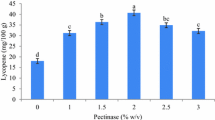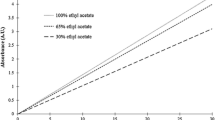Abstract
The lycopene pigment found abundantly in tomato peels has been proven to own antioxidant capacity and reduce risks of getting cancers. The present study aimed to investigate effects of enzymatic pretreatment to assist lycopene extraction from tomato peels using rice bran oil (RBO) as a green solvent. The peels were pretreated using Viscozyme L at different concentrations (0.5–2.5%), different incubation temperatures (30–70 °C), and incubation durations (30–150 min). The enzyme-assisted extraction conditions for lycopene from tomato peels were optimized using response surface methodology (RSM) based on Box–Behnken design with three levels of design factors (− 1, 0, and + 1). Pretreated peels were then extracted for 30 min at 25 °C using rice bran oil at a solid/oil ratio of 1:20 (w/v). Lycopene concentration were concurrently analyzed using Ultra Performance Liquid Chromatography system. The optimal extraction condition was 1.4% Viscozyme L incubated at 52 °C for 92 min resulted in a rice bran oil sample containing the highest concentration of lycopene (0.75 mg lycopene/100 ml rice bran oil or 399.6 mg lycopene/100 g dried tomato peels). Lycopene extraction using RBO along with Viscozyme L assistance could be a friendly extraction method to utilize the tomato-processing waste. RMS has been an effective tool for determining the optimal lycopene extraction conditions required to achieve a lycopene-containing oil product with both health and economic potential.


Similar content being viewed by others
Data availability
Not applicable.
References
M.T. Melfi, D. Nardiello, N. Cicco, V. Candido, D. Centonze, Simultaneous determination of water-and fat-soluble vitamins, lycopene and beta-carotene in tomato samples and pharmaceutical formulations: double injection single run by reverse-phase liquid chromatography with UV detection. J. Food Compos. Anal. 70, 9–17 (2018)
U.M. Sainju, R. Dris, B. Singh, Mineral nutrition of tomato. Food Agric. Environ. 1(2), 176–183 (2003)
B. Salehi, R. Sharifi-Rad, F. Sharopov, J. Namiesnik, A. Roointan, M. Kamle, P. Kumar, N. Martins, J. Sharifi-Rad, Beneficial effects and potential risks of tomato consumption for human health: an overview. Nutrition 62, 201–208 (2019)
R.C. Ranveer, S.N. Patil, A.K. Sahoo, Effect of different parameters on enzyme-assisted extraction of lycopene from tomato processing waste. Food Bioprod. Process. 91(4), 370–375 (2013)
J. Shi, M. Le Maguer. Degradation of lycopene in tomato processing. Paper presented at the VII International Symposium on the Processing Tomato 542. (2000)
M.M. Poojary, P. Passamonti, Extraction of lycopene from tomato processing waste: kinetics and modelling. Food Chem. 173, 943–950 (2015)
S. Machmudah, S. Winardi, M. Sasaki, M. Goto, N. Kusumoto, K. Hayakawa, Lycopene extraction from tomato peel by-product containing tomato seed using supercritical carbon dioxide. J. Food Eng. 108(2), 290–296 (2012)
E.H. Papaioannou, A.J. Karabelas, Lycopene recovery from tomato peel under mild conditions assisted by enzymatic pre-treatment and non-ionic surfactants. Acta Biochim. Pol. 59(1), 71–74 (2012)
T. Baysal, S. Ersus, D. Starmans, Supercritical CO2 extraction of β-carotene and lycopene from tomato paste waste. J. Agric. Food Chem. 48(11), 5507–5511 (2000)
M.J. Periago, F. Rincon, M.D. Agüera, G. Ros, Mixture approach for optimizing lycopene extraction from tomato and tomato products. J. Agric. Food Chem. 52(19), 5796–5802 (2004)
R. Ciriminna, A. Fidalgo, F. Meneguzzo, L.M. Ilharco, M. Pagliaro, Lycopene: emerging production methods and applications of a valued carotenoid. ACS Sustain. Chem. Eng. 4(3), 643–650 (2016)
R. Lavecchia, A. Zuorro, Improved lycopene extraction from tomato peels using cell-wall degrading enzymes. Eur. Food Res. Technol. 228(1), 153–158 (2008)
G.W. Cheng, D.J. Huber, Alterations in structural polysaccharides during liquefaction of tomato locule tissue. Plant Physiol. 111(2), 447–457 (1996)
N.T. Huynh, G. Smagghe, G.B. Gonzales, J. Van Camp, K. Raes, Enzyme-assisted extraction enhancing the phenolic release from cauliflower (Brassica oleracea L. var. botrytis) outer leaves. J. Agric. Food Chem. 62(30), 7468–7476 (2014)
N. Ratnasari, M. Walters, A. Tsopmo, Antioxidant and lipoxygenase activities of polyphenol extracts from oat brans treated with polysaccharide degrading enzymes. Heliyon 3(7), e00351 (2017)
M. Kehili, S. Sayadi, F. Frikha, A. Zammel, N. Allouche, Optimization of lycopene extraction from tomato peels industrial by-product using maceration in refined olive oil. Food Bioprod. Process. 117, 321–328 (2019)
M.H. Zuknik, N.N. Norulaini, A.M. Omar, Supercritical carbon dioxide extraction of lycopene: a review. J. Food Eng. 112(4), 253–262 (2012)
A. Ali, S. Devarajan, Nutritional and health benefits of Rice bran oil, in Brown rice. ed. by A. Manickavasagan, C. Santhakumar, N. Venkatachalapathy (Springer, Cham, 2017), pp.135–158
X. Guan, H. Yao, Optimization of Viscozyme L-assisted extraction of oat bran protein using response surface methodology. Food Chem. 106(1), 345–351 (2008)
U.S.D.A. Tomatoes, Shipping point and market inspection instructionsUnited States (Department of Agriculture, Washington, 2005)
H. Kelebek, S. Selli, P. Kadiroğlu, O. Kola, S. Kesen, B. Uçar, B. Çetiner, Bioactive compounds and antioxidant potential in tomato pastes as affected by hot and cold break process. Food Chem. 220, 31–41 (2017)
S.M. Choudhari, L. Ananthanarayan, Enzyme aided extraction of lycopene from tomato tissues. Food Chem. 102(1), 77–81 (2007)
T. Sathish, D. Udayakiran, K. Himabindu, P.L.D. Sridevi, D. Kezia, P. Bhojaraju, HPLC method for the determination of lycopene in crude oleoresin extracts. Asian J. Chem. 21(1), 139 (2009)
T.M.T. Nguyen, M.T. Nguyen, Effect of enzymatic treatments on lycopene in vitro bioaccessibility in high pressure homogenized tomato puree and chromoplast fraction. Can Tho Univ. J. Sci. 01, 61–68 (2015)
I. Çinar, Effects of cellulase and pectinase concentrations on the colour yield of enzyme extracted plant carotenoids. Process Biochem. 40(2), 945–949 (2005)
V.P. Nam, Improvement of lycopene extraction from tomatoes by enzyme–assisted treatment. Vietnam J. Sci. Technol. 54(4A), 275–275 (2016)
M.R. Ladole, A.B. Muley, I.D. Patil, M. Talib, V.R. Parate, Immobilization of tropizyme-P on amino-functionalized magnetic nanoparticles for fruit juice clarification. J. Biochem. Technol. 5(4), 838–845 (2015)
A. Sahoo, P.S. Badhe, R. Adivarekar, M.R. Ladole, A.B. Pandit, Synthesis of glycinamides using protease immobilized magnetic nanoparticles. Biotechnol. Rep. 12, 13–25 (2016)
J. Chen, J. Shi, S.J. Xue, Y. Ma, Comparison of lycopene stability in water-and oil-based food model systems under thermal-and light-irradiation treatments. LWT Food Sci. Technol. 42(3), 740–747 (2009)
A. Zuorro, M. Fidaleo, R. Lavecchia, Enzyme-assisted extraction of lycopene from tomato processing waste. Enzyme Microb. Technol. 49(6–7), 567–573 (2011)
R.K. Saini, A.E.-D.A. Bekhit, S. Roohinejad, K.R. Rengasamy, Y.-S. Keum, Chemical stability of lycopene in processed products: a review of the effects of processing methods and modern preservation strategies. J. Agric. Food Chem. 68(3), 712–726 (2019)
C. Caris-Veyrat, A. Schmid, M. Carail, V. Böhm, Cleavage products of lycopene produced by in vitro oxidations: characterization and mechanisms of formation. J. Agric. Food Chem. 51(25), 7318–7325 (2003)
S. Das, S. Mishra, Box–Behnken statistical design to optimize preparation of activated carbon from Limonia acidissima shell with desirability approach. J. Environ. Chem. Eng. 5(1), 588–600 (2017)
R.K. Agarwal, S.J.D. Bosco, Optimization of viscozyme L assisted extraction of coconut milk and virgin coconut oil. Asian J. Dairy Food Res. 33(4), 276–284 (2014)
E.A. Abd El-Salam, N.F. Morsy, Optimization of the extraction of polyphenols and antioxidant activity from Malva parviflora L. leaves using Box-Behnken design. Prep. Biochem. Biotechnol. 49(9), 876–883 (2019)
G. Chen, Z. Djuric, Carotenoids are degraded by free radicals but do not affect lipid peroxidation in unilamellar liposomes under different oxygen tensions. FEBS Lett. 505(1), 151–154 (2001)
Acknowledgements
This research is funded by International University, VNU-HCM under grant number T2020-06-BT
Author information
Authors and Affiliations
Corresponding author
Additional information
Publisher's Note
Springer Nature remains neutral with regard to jurisdictional claims in published maps and institutional affiliations.
Rights and permissions
Springer Nature or its licensor (e.g. a society or other partner) holds exclusive rights to this article under a publishing agreement with the author(s) or other rightsholder(s); author self-archiving of the accepted manuscript version of this article is solely governed by the terms of such publishing agreement and applicable law.
About this article
Cite this article
Tran, Q.T.N., Nguyen, H.V.H. Optimization of enzyme-assisted lycopene extraction from tomato (Lycopersicon esculentum) peel using rice bran oil. Food Measure 17, 5154–5162 (2023). https://doi.org/10.1007/s11694-023-02029-w
Received:
Accepted:
Published:
Issue Date:
DOI: https://doi.org/10.1007/s11694-023-02029-w




